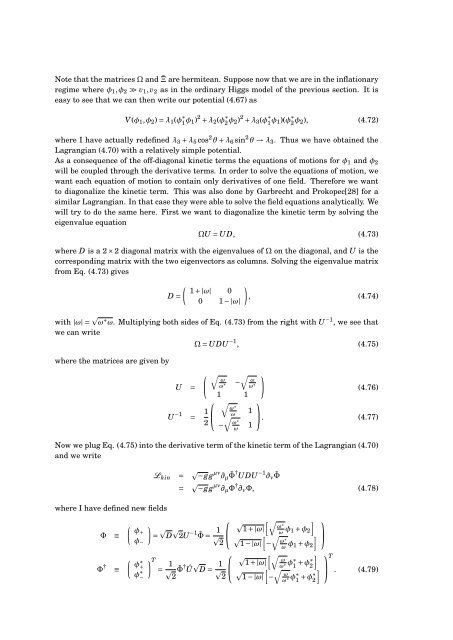Master's Thesis in Theoretical Physics - Universiteit Utrecht
Master's Thesis in Theoretical Physics - Universiteit Utrecht
Master's Thesis in Theoretical Physics - Universiteit Utrecht
You also want an ePaper? Increase the reach of your titles
YUMPU automatically turns print PDFs into web optimized ePapers that Google loves.
Note that the matrices Ω and ˜Ξ are hermitean. Suppose now that we are <strong>in</strong> the <strong>in</strong>flationaryregime where φ 1 ,φ 2 ≫ v 1 , v 2 as <strong>in</strong> the ord<strong>in</strong>ary Higgs model of the previous section. It iseasy to see that we can then write our potential (4.67) asV (φ 1 ,φ 2 ) = λ 1 (φ ∗ 1 φ 1) 2 + λ 2 (φ ∗ 2 φ 2) 2 + λ 3 (φ ∗ 1 φ 1)(φ ∗ 2 φ 2), (4.72)where I have actually redef<strong>in</strong>ed λ 3 + λ 5 cos 2 θ + λ 6 s<strong>in</strong> 2 θ → λ 3 . Thus we have obta<strong>in</strong>ed theLagrangian (4.70) with a relatively simple potential.As a consequence of the off-diagonal k<strong>in</strong>etic terms the equations of motions for φ 1 and φ 2will be coupled through the derivative terms. In order to solve the equations of motion, wewant each equation of motion to conta<strong>in</strong> only derivatives of one field. Therefore we wantto diagonalize the k<strong>in</strong>etic term. This was also done by Garbrecht and Prokopec[28] for asimilar Lagrangian. In that case they were able to solve the field equations analytically. Wewill try to do the same here. First we want to diagonalize the k<strong>in</strong>etic term by solv<strong>in</strong>g theeigenvalue equationΩU = UD, (4.73)where D is a 2 × 2 diagonal matrix with the eigenvalues of Ω on the diagonal, and U is thecorrespond<strong>in</strong>g matrix with the two eigenvectors as columns. Solv<strong>in</strong>g the eigenvalue matrixfrom Eq. (4.73) gives( 1 + |ω| 0D =0 1 − |ω|), (4.74)with |ω| = ω ∗ ω. Multiply<strong>in</strong>g both sides of Eq. (4.73) from the right with U −1 , we see thatwe can writewhere the matrices are given byU =Ω = UDU −1 , (4.75)( √ √ω− ωω ∗ ω ∗1 1⎛√ω ∗U −1 = 1 ⎝ √2 −ω1ω ∗ω1⎞)(4.76)⎠. (4.77)Now we plug Eq. (4.75) <strong>in</strong>to the derivative term of the k<strong>in</strong>etic term of the Lagrangian (4.70)and we writewhere I have def<strong>in</strong>ed new fieldsΦΦ †≡≡(φ+L k<strong>in</strong> = −gg µν ∂ µ ˜Φ † UDU −1 ∂ ν ˜Φ= −gg µν ∂ µ Φ † ∂ ν Φ, (4.78)⎛)= D 2U −1 ˜Φ = 1 ⎝φ − 2( φ∗+φ ∗ −) T= 1 2˜Φ † Û D = 1 2⎛⎝ [√ ]1 + |ω|ω ∗ω φ 1 + φ 2 [ √ ]1 − |ω|ω−∗ω φ 1 + φ 2 [√1 + |ω|ωφ ∗ ω ∗ 1 2]+ φ∗ []1 − |ω| −√ωφ ∗ ω ∗ 1 + φ∗ 2⎞⎠⎞⎠T. (4.79)
















